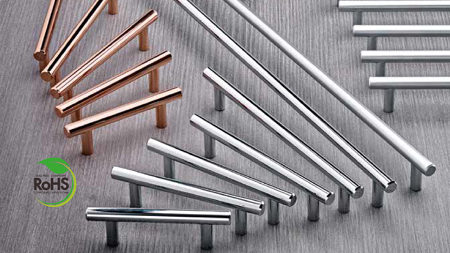RoHS Decorative Hardware
Throughout the past century manufacturing technology has increasingly evolved and transformed. Richelieu recognizes the importance of offering RoHS compliant products for the building and housing industry.
Why is RoHS compliance important?
The restricted materials are hazardous to the environment and pollute landfills, and are dangerous in terms of occupational exposure during manufacturing and recycling.
What are the restricted materials mandated under RoHS?
The European RoHS certification is identified by the CE and RoHS logos to limit the use of six dangerous substances.
Dangerous SubstancesMaximum Concentration Lead 0.1% Mercury 0.1% Cadmium 0.01% Hexavalent Chromium 0.1% Polybrominated Biphenyls (PBBs) 0.1% Polybrominated Diphenyl Ethers (PBDEs) 0.1%
This directive, also called "recast of the RoHS Directive" or "RoHS II", regulates the use of dangerous products in electrical and electronic equipment in EU member states. It replaces the 2002/95/CE directive. The goal of this amendment is an additional restriction on dangerous and polluting products among electronic and electrical equipment for the protection of people and the environment. RoHS means Restriction of the use of certain Hazardous Substances in Electrical and Electronic equipment.
Concerned with issues related to public health, occupational health, environmental health, economy and development, and compelled by the increasing scarcity of certain precious metals, which was causing wars and local tensions. The European parliament wanted to standardize national regulations, which were still very uneven across Europe. Besides, the differences between national management policies and the WEEE (waste electrical and electronic equipment) directive compromise the effectiveness of recycling policies. For these reasons, the essential criteria had to be set at the Union level and in the minimum standards for WEEE treatment.
Concerned equipment
Category 1: large household appliances
Category 2: small household appliances
Category 3: IT and telecommunications equipment
Category 4: consumer equipment
Category 5: lighting equipment
Category 6: electronic and electrical tools
Category 7: toys, leisure and sports equipment
Category 8: medical devices
Category 9: monitoring and control instruments
Category 10: automatic dispensers
Category 11: other electric and electronic equipment outside the above-mentioned categories
Batteries are not affected by the directive.
According to the EU directive on waste electrical and electronic equipment, product manufacturers must reuse, recycle and recover WEEE and plastic materials containing brominated flame retardants (PBDEs) must be eliminated from this type of equipment waste in an appropriate manner.
This directive applies to all the new products on the market in the European Union, whether they are imported or manufactured in the Union.
Labeling
Since July 1, 2016, all new products on the European market are supposed to be compliant. The new RoHS directive assumes equipment with the "CE" label to be compliant unless otherwise indicated. However, some manufacturers have introduced their own system of Pb-free, Mercury-free, RoHS compliant and Lead-free, etc. identification.






















